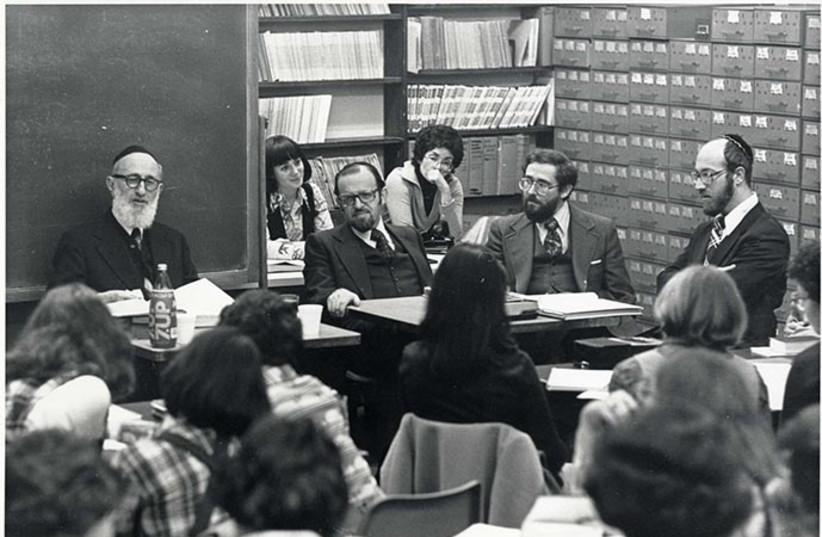This year marks the 100th anniversary of the introduction of the worldwide Daf Yomi (“a page a day”) study of the Talmud, as well as the 500th anniversary of the first printing of the Talmud.
Implemented in 1923 by Rabbi Meir Shapiro of Lublin, Poland, to encourage Jewish learning, Daf Yomi involves the synchronized daily study of both sides of a single Talmud page. A single cycle takes approximately seven and a half years. The 13th cycle, involving 350,000 participants worldwide, ended on January 1, 2020, with a concluding celebration, Siyum HaShas.
For those of us who are not accomplished Talmud scholars (myself included): What is the Talmud?
The Talmud is composed of first Mishna and then Gemara. Mishnah is a compendium of exegetical material embodying the oral tradition of Jewish law. Gemara is a rabbinical commentary on the Mishnah, first written early in the Common Era. Extensive commentaries were added throughout the Middle Ages and beyond, and as Rabbi Adin Steinsaltz notes in The Essential Talmud (1976), Talmud scholarship is ongoing today.
There are two Talmuds: Talmud Yerushalmi (the “Jerusalem Talmud”) written primarily in Galilee after the Roman destruction of Jerusalem; and the Talmud Bavli (the Bavli Talmud), written in Babylon (modern-day Iraq) in various Jewish academies, the most prominent of which were at Sura and Pumbedita (with the latter today known as Fallujah).
The Babylonian Talmud, containing 2,711 double-sided folios organized as 63 tractates, or treatises, is larger than the Jerusalem Talmud and its discussions are more extensive and far-reaching. When speaking of the Talmud in the singular, it is this multi-volume text that is being referred to and it is this work that is studied in the Daf Yomi project.
Before the invention of the printing press by Gutenberg in the 15th century, each copy of the Talmud was a hand-written manuscript. As mentioned earlier, 2023 also marks the 500th anniversary since the completion, in Venice, of the first printed Talmud. The printer, Daniel Bomberg, was a non-Jew with experience in the printing of Hebrew books and Venice was an important 16th-century printing center. (See Marvin J. Heller’s article, “Designing the Talmud, Tradition,” 1995)

The existence of the Talmud did not mesh with the common Christian belief in supersession (or replacement theology), where Christianity is seen as Judaism’s successor. Indeed, hostility to the Talmud led to centuries of censorship and public burnings. In 1240, 24 wagon-loads of (handwritten) Talmuds were burned in Paris; while the last public burning (previous to the Nazi period), took place in Poland in 1757. Bomberg’s Babylonian Talmud could only be printed after he was authorized to do so by Pope Leo X.
The typographical architecture of a page of the Talmud is just as innovative and important as the invention of printing. The first printing in 1883, barely 30 years after the printing of the Gutenberg Bible, was of the tractate Berachot by the Jewish Italian printer, Joshua Solomon Soncino. The typographical arrangement he developed was also adopted by Bomberg and has become the standard layout ever since.
The Mishna and its commentary the Gemara, in block letters, occupy the upper middle of the page. Much of the rest of the page comprises the commentaries by Rashi (Rabbi Shlomo Yitzhaki), a renowned medieval French scholar) as well as those by the Tosafists, a subset of sages – among them Rashi’s descendants and disciples – who made their contributions from the 12th-15th centuries.
Rashi’s commentary (in a semi-cursive font known as “Rashi script”) is found near the binding, and thus on the less exposed side of the page, while that of the Tosafists, also in semi-cursive script, occupies the outer margin. The commentaries typically begin at the top of the page, four lines above the first line of the Mishnah and Gemara, in effect encapsulating the Mishna and Gemara. Commentaries added later are located at the extreme outer, inner and bottom margins of the page.
The layout can be described as a spiral, or a calligraphic solar system, with “idea units circulating like moons around a major planet” (Mitchell Schwarzer, “The Architecture of Talmud,” Journal of Architectural Historians, 2002). In fact, the Talmud has also been described as a form of hypertext, in that it is a text built on previous texts and open to further additions. “One reads the printed Talmud as a conversation over many centuries.”
The first English translation of a tractate of the Babylonian Talmud was published in 1891 and translations to Modern Hebrew and English by Steinsaltz have been available for a while. More recently, the Talmud, as well as the translations, have been placed on the Sefaria platform, the free access web-interactive platform for Jewish texts, making them available to a much wider audience.
In his 2018 book 21 Lessons for the 21st Century, a book about contemporary challenges, the Israeli historian Yuval Noah Harari describes the Talmud as unimportant beyond the Jewish world, calling it “an esoteric text.” However, in light of the recent educational developments in Asia alone, Harari’s comment may be off the mark. In recent years, both the study of the Talmud itself, as well as the adaption of the havruta approach (studying in pairs) have been applied to other subjects and overtaken the South Korean educational system. Jewish Studies programs that include Talmud study, have appeared in Chinese universities as well.
Steinsaltz describes the Talmud as the repository of thousands of years of Jewish wisdom. Why shouldn’t it attract wider interest now that it is much more accessible?
The writer, a Fellow of the Royal Society of Canada, is a retired professor from the University of Waterloo.
